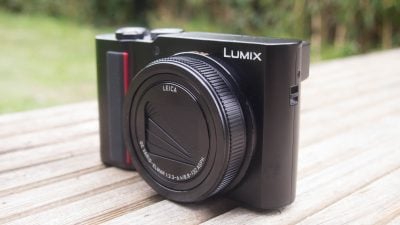Panasonic Lumix TZ200 ZS200 review
-
-
Written by Ken McMahon
Quality
To test real-life performance, I shot this scene with the Panasonic Lumix TZ200 / ZS200 using its best quality JPEG mode. The TZ200 / ZS200 was mounted on a tripod and image stabilisation was disabled, the sensitivity was manually set to 125 ISO and Aperture priority mode was selected for the exposure. The TZ200 / ZS200 has optional diffraction compensation which attempts to correct for the reduction in image quality caused by light diffraction at small aperture sizes. Diffraction compensation is turned off by default and so that’s where I left it for these quality tests.
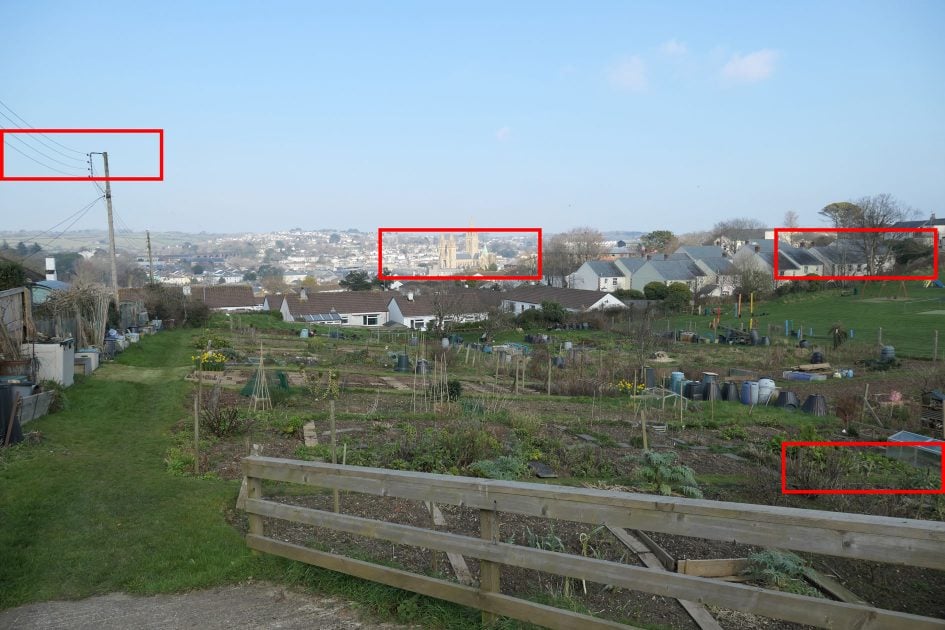
Panasonic Lumix TZ200 / ZS200 at 8.8mm (24mm equivalent)
For this first test I set the Lumix TZ200 / ZS200 to its shortest 24mm equivalent wide angle setting and selected an aperture of f4 – which I’d previously determined produced the best quality results. As usual the crops below are taken from the areas marked in red above. Looking at the first crop, from close to the left edge of the frame I’ll admit to being quite impressed. At the 24mm wide angle setting, and this close to the frame edge I’d expect to see a little bit of distortion, or evidence of lens aberrations but the detail is pretty sharp. There’s the merest hint of colour fringing but you have to look very closely to spot it. It’s a great start for the Lumix TZ200 / ZS200’s new 15x lens and the sensor does a good job here too. The phone lines are crisply defined with no haloing and no evidence of noise in the pale blue sky.
Moving on to the second crop from the central area of the frame, here there’s plenty of fine detail being picked up by the lens and sensor combination and you’d probably be able to see more if that portion of the frame weren’t in bright sunshine. Even so, you can pick out a lot of detail in the cathedral stonework and in the houses on the hill rising behind it. The final two crops from the left and bottom edges of the frame respectively look a tiny bit softer, but overall this is an excellent result for the TZ200 /ZS200 at its shortest focal length. We already knew from its predecessor that the one inch sensor used in both the TZ200 / ZS100 and the earlier TZ100 / ZS100 produced good results, but these are the first results I’ve seen from the TZ200 / ZS200’s new 15x zoom and the quality, at this focal length at least, looks to be at least as good as the 10x lens of its predecessor. Next scroll down to see how the Lumix TZ200 / ZS200 performs at longer focal lengths.

Panasonic Lumix TZ200 / ZS200 at 8.8mm (24mm equivalent)

Panasonic Lumix TZ200 / ZS200 at 8.8mm (24mm equivalent)

Panasonic Lumix TZ200 / ZS200 at 8.8mm (24mm equivalent)

Panasonic Lumix TZ200 / ZS200 at 8.8mm (24mm equivalent)
Panasonic Lumix TZ200 / ZS200 quality at 120mm
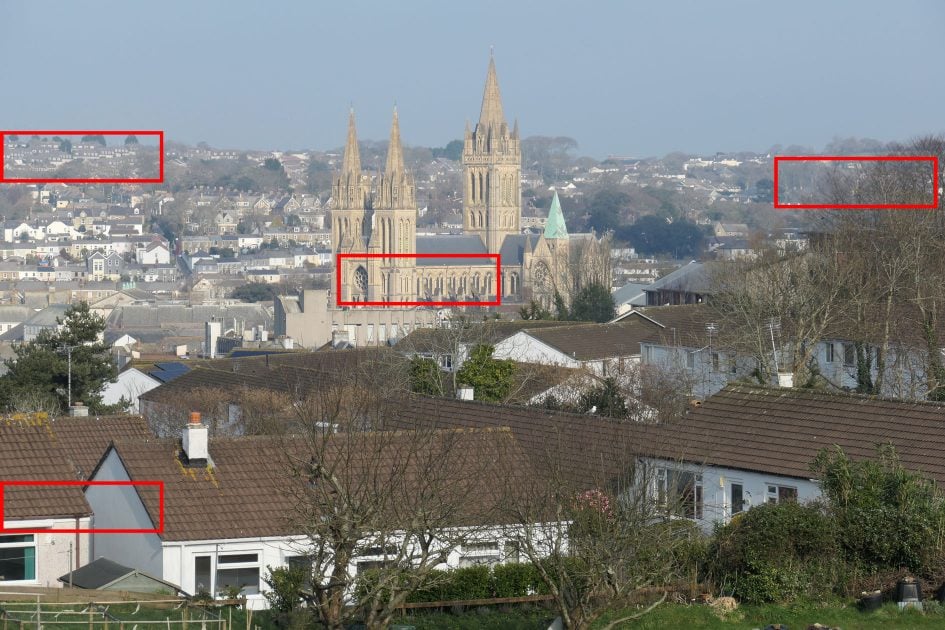
Here I’ve zoomed the Lumix TZ200 / ZS200 in to a ‘middling’ focal length of 120mm equivalent. The first crop is lacking in contrast and looks a little milky on account of the slight atmospheric haze, but otherwise it looks very good indeed for a crop taken from close to the edge of the frame. Admittedly, you can’t make out much detail in the roofs but that’s I think mostly due to the haze; the window frames are sharp and well defined and there’s no evidence of distortion or colour fringing. The second crop is from the same edge closer to the bottom of the frame and because the detail is closer there’s no haze issue. Once again there’s a good level of detail here and no issues to report either with the lens or the sensor. The third crop is from the opposite edge of the frame in the top right corner. Once again, it’s sharp and there’s plenty of detail but there is some noticeable purple fringing in the trees. Finally there’s the crop from the central area of the frame where, perhaps not surprisingly, there’s lots of nice sharp detail in the cathedral stonework. Overall, a great result for the Lumix TZ200 / ZS200 in the middle of its zoom range.
Finally, you can scroll down to see my results with the Lumix TZ200 / ZS200 fully zoomed to its maximum 360mm equivalent focal length.

Panasonic Lumix TZ200 / ZS200 at 44mm (120mm equivalent)

Panasonic Lumix TZ200 / ZS200 at 44mm (120mm equivalent)

Panasonic Lumix TZ200 / ZS200 at 44mm (120mm equivalent)

Panasonic Lumix TZ200 / ZS200 at 44mm (120mm equivalent)
Panasonic Lumix TZ200 / ZS200 quality at 360mm
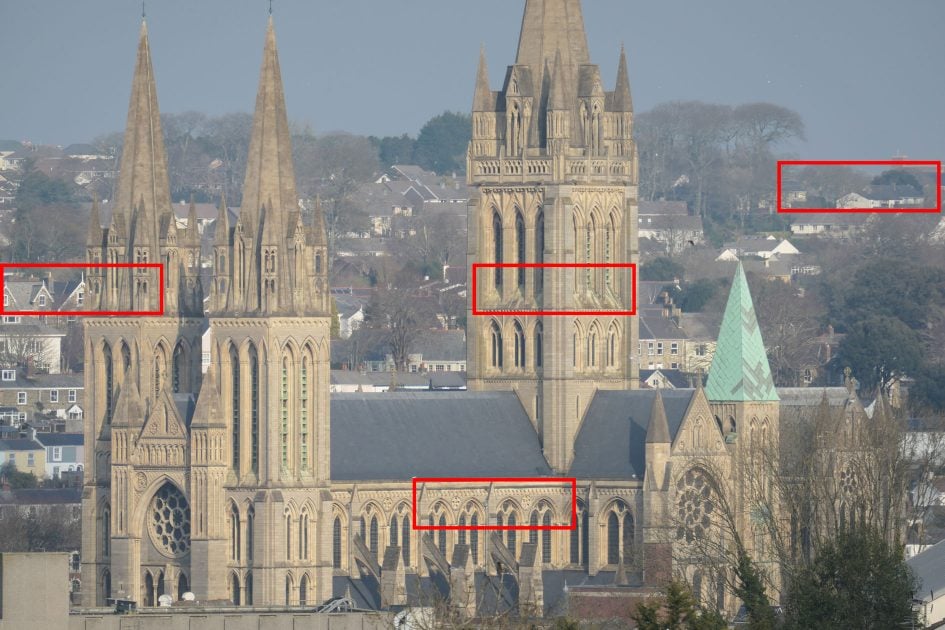
Here I’ve zoomed the Lumix TZ200 / ZS200 to its maximum 360mm equivalent focal length, at which point the aperture closes to f6.4. Starting with crop one from the left edge of the frame, despite the haze, (and just to note, the cathedral is nearly a Kilometre away from where I was standing when I took this shot) the detail here is sharp and well defined – you can make out the individual roof tiles and other details in the houses behind the cathedral. The next two crops, from high and low in the middle of the frame are hard to fault, with plenty of crisp detail. The final crop, from the top left corner, is the least impressive of any of them; it looks soft and it’s hard to make out the detail in the trees, but what detail there is – for example the windows – is sharp. I think it’s fair to say on the basis of these test results that the Lumix TZ200 / ZS200 produces excellent results across the frame throughout its zoom range.
If you continue to scroll you can see how the Lumix TZ200 / ZS200 performs in low light throughout it sensitivity range.

Panasonic Lumix TZ200 / ZS200 at 132mm (360mm equivalent)

Panasonic Lumix TZ200 / ZS200 at 132mm (360mm equivalent)

Panasonic Lumix TZ200 / ZS200 at 132mm (360mm equivalent)

Panasonic Lumix TZ200 / ZS200 at 132mm (360mm equivalent)
Panasonic Lumix TZ200 / ZS200 Noise
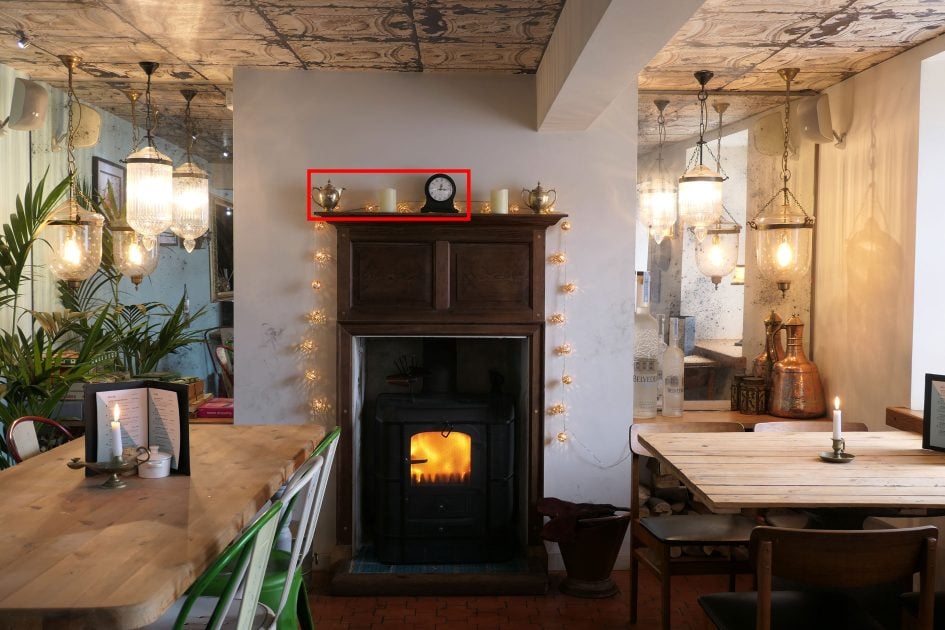
To examine noise levels under real-life conditions, I shot this scene with the Panasonic Lumix TZ200 / ZS200 at each of its ISO settings.The TZ200 / ZS100 was set to RAW+JPEG mode and mounted on a tripod with stabilisation disabled.
I zoomed the TZ200 / ZS100 in a little to an equivalent focal length of 35mm. The ISO sensitivity was manually set to the lowest available setting and Aperture priority mode was selected for the exposure. I’d previously determined that f4 produced the best results from the TZ200 / ZS200 and with the aperture set to f4 and the sensitivity set to 125 ISO, it metered an exposure of 1/3s. Just to note the sensitivity range of the Lumix TZ200 / ZS200 is 125 to 12800 ISO, but it can be extended to 80 to 25600 ISO. For the sake of completeness I’ve included the extended settings but just be aware the base sensitivity setting in the normal range is 125 ISO.
Looking at the first three crops, at 80, 100 and 125 ISO, I have to admit I’m finding it difficult to tell them apart. No doubt the noise difference is measurable, but I can’t see it. I wouldn’t mind betting that most TZ200 / ZS200 users don’t turn on the extended ISO range, and on this evidence they’re not really missing out, at least at the bottom end of the sensitivity range.
The base 125 ISO crop itself looks nice and clean with no evidence of noise textures and while at 200 ISO you can just begin to make out some grain, it’s marginal and you have to be looking very closely at these 100 percent crops to spot it. With the increase to 400 ISO the noise textures are becoming a little more obvious and at 800 ISO it’s clear that the noise is beginning to impact a little on image detail. That said, even though at 1600 ISO the noise is quite plain to see in these 100 percent crops, you wouldn’t notice it at smaller sizes.
Moving into the higher ISO sensitivity range, at 3200 ISO there’s still a good level of detail and this would look passable even close to 100 percent. Beyond 3200 ISO though, the noise gets the upper hand and image detail is suffering quite badly, though you can still read the time on the clock even at 6400 ISO. I doubt whether the result of underexposing by a stop would be any worse in terms of quality than the significant ramp up in noise and consequent destruction that results in the step up to 25600 ISO, so once again the advantage to be had from the extended ISO range is questionable. Overall though, this is a pretty impressive set of noise results from the Lumix TZ200 / ZS200’s 1 inch 20 Megapixel sensor.

Panasonic Lumix TZ200 / ZS200 80 ISO

Panasonic Lumix TZ200 / ZS200 100 ISO

Panasonic Lumix TZ200 / ZS200 125 ISO

Panasonic Lumix TZ200 / ZS200 200 ISO

Panasonic Lumix TZ200 / ZS200 400 ISO

Panasonic Lumix TZ200 / ZS200 800 ISO

Panasonic Lumix TZ200 / ZS200 1600 ISO

Panasonic Lumix TZ200 / ZS200 3200 ISO

Panasonic Lumix TZ200 / ZS200 6400 ISO

Panasonic Lumix TZ200 / ZS200 12800 ISO

Panasonic Lumix TZ200 / ZS200 25600 ISO
Next check out my sample images or skip to my verdict using the tabs above.
Check prices at Amazon, B&H, Adorama, or Wex. Alternatively get yourself a copy of my In Camera book or treat me to a coffee! Thanks!



